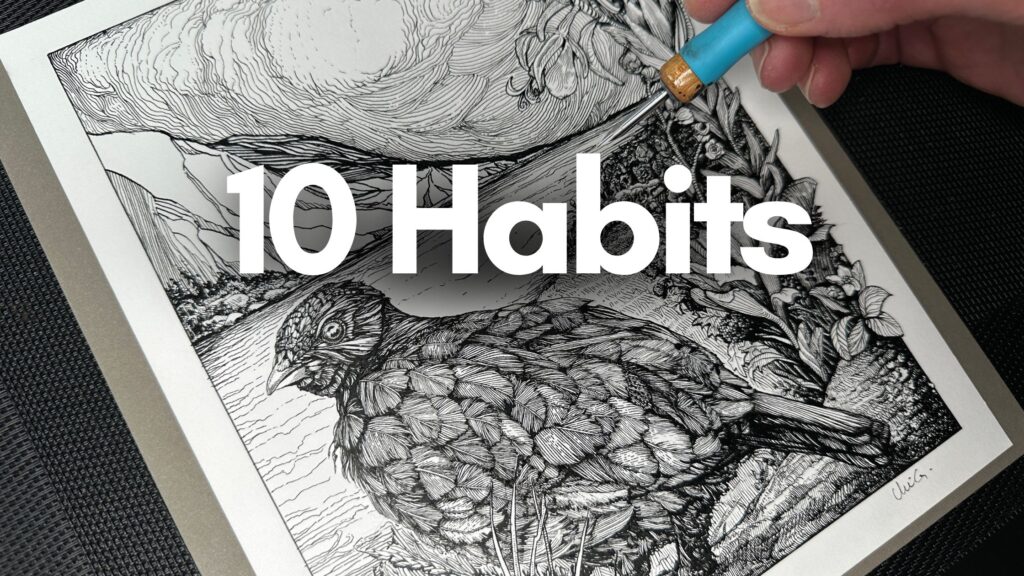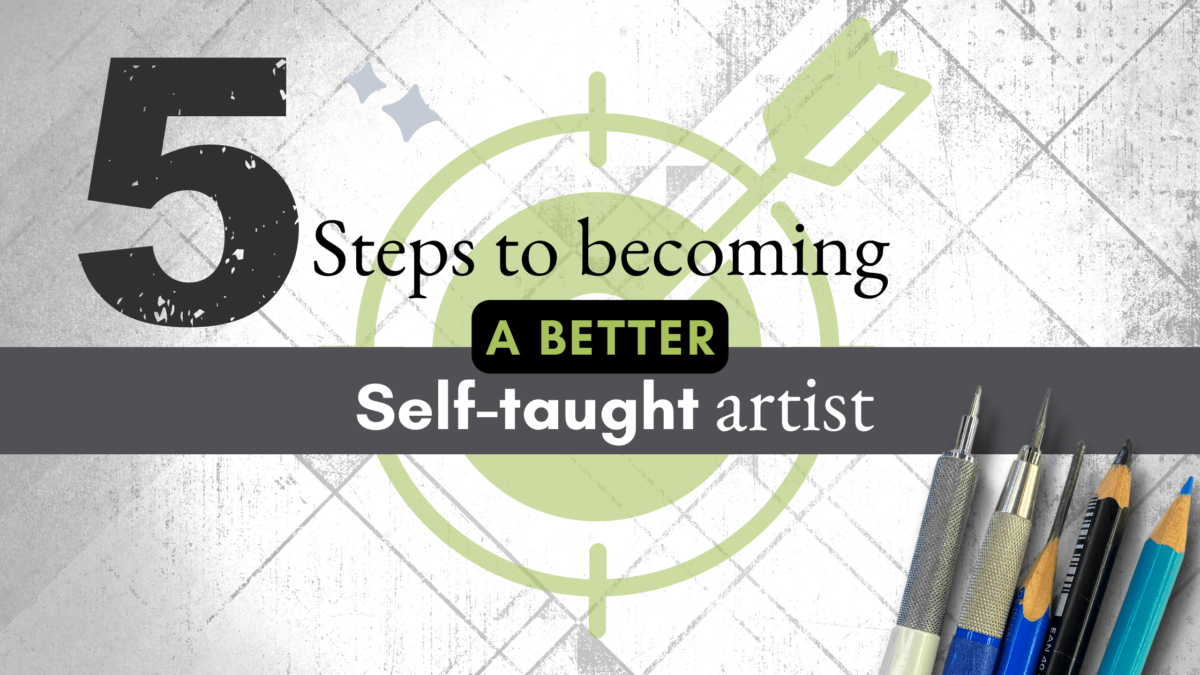In this article, I review the 10 habits that help keep my progress consistent as an artist.
How to Progress with Habits
From reading my Blog, it might seem like ‘Studying the Masters’ is my no.1 focus.
However, for habits to stick, everything stems from the learning plan.
// DISCLOSURE: I earn a small commission when you use my affiliate links to make a purchase. Please read the Terms for more information.
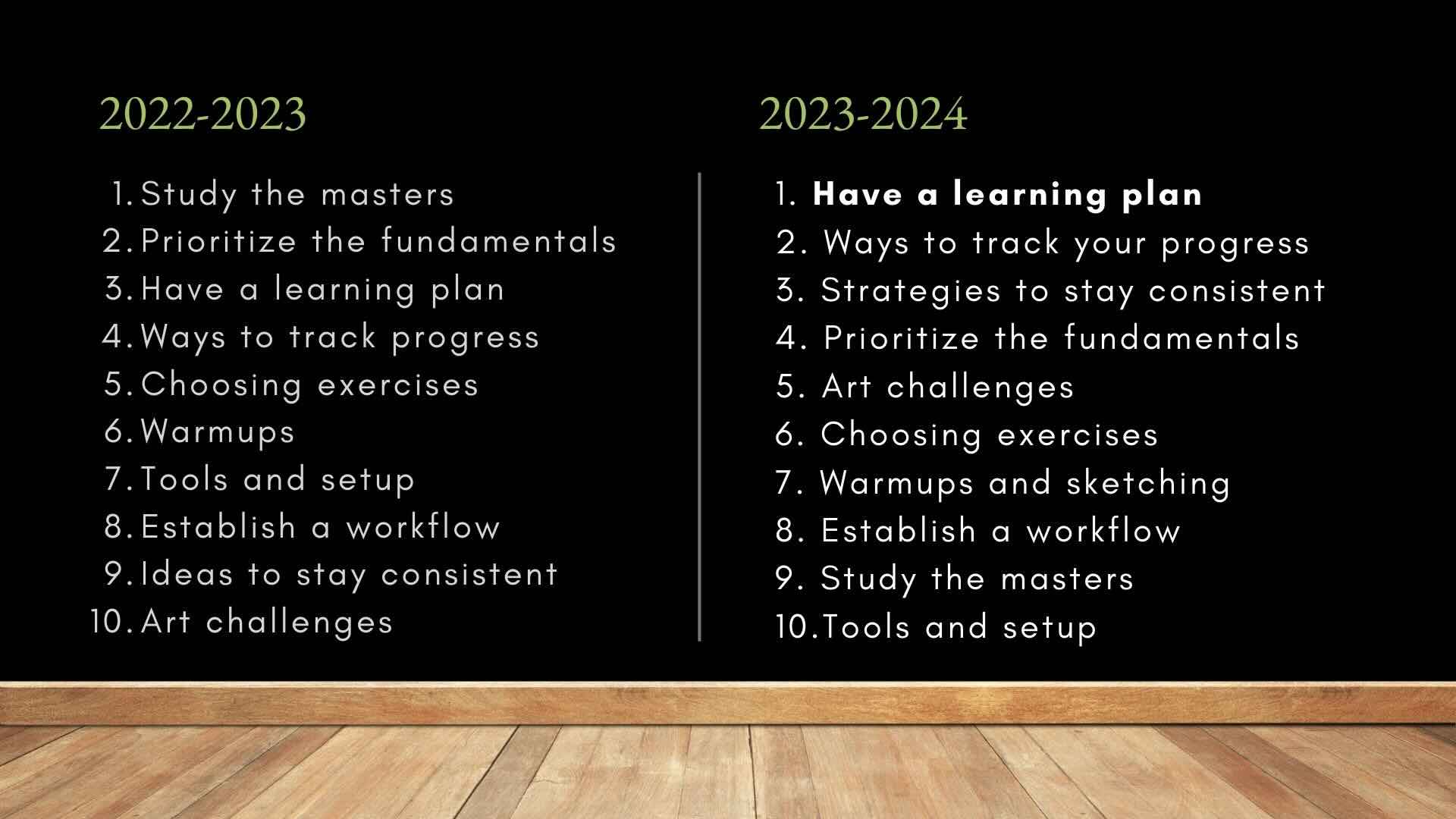
1. Have a Learning Plan
Keen to learn pen and ink, as a beginner I watched every YouTube tutorial.
I got the recommended art books, signed up for fun drawing lessons, and filled my sketchbooks with doodles as often as possible.
Those were the most common tips:
- Take lessons
- Read books
- Practice a lot
These activities are useful when you’re starting out because it’s a chance to discover your preferences, such as:
- Which subjects you most like to draw;
- What art styles you’re attracted to; and
- Familiarization with the tools and the medium.
The danger is getting stuck drawing only what you’re good at, in one style, using your favourite tools.
If you do this long enough, the rut gets bigger and harder to climb out of. At that point, attempts to practice a different subject, in another style, using a new tool, sets you back to square one.
Except that, mentally, it feels worse than square one because now you have something to compare to.
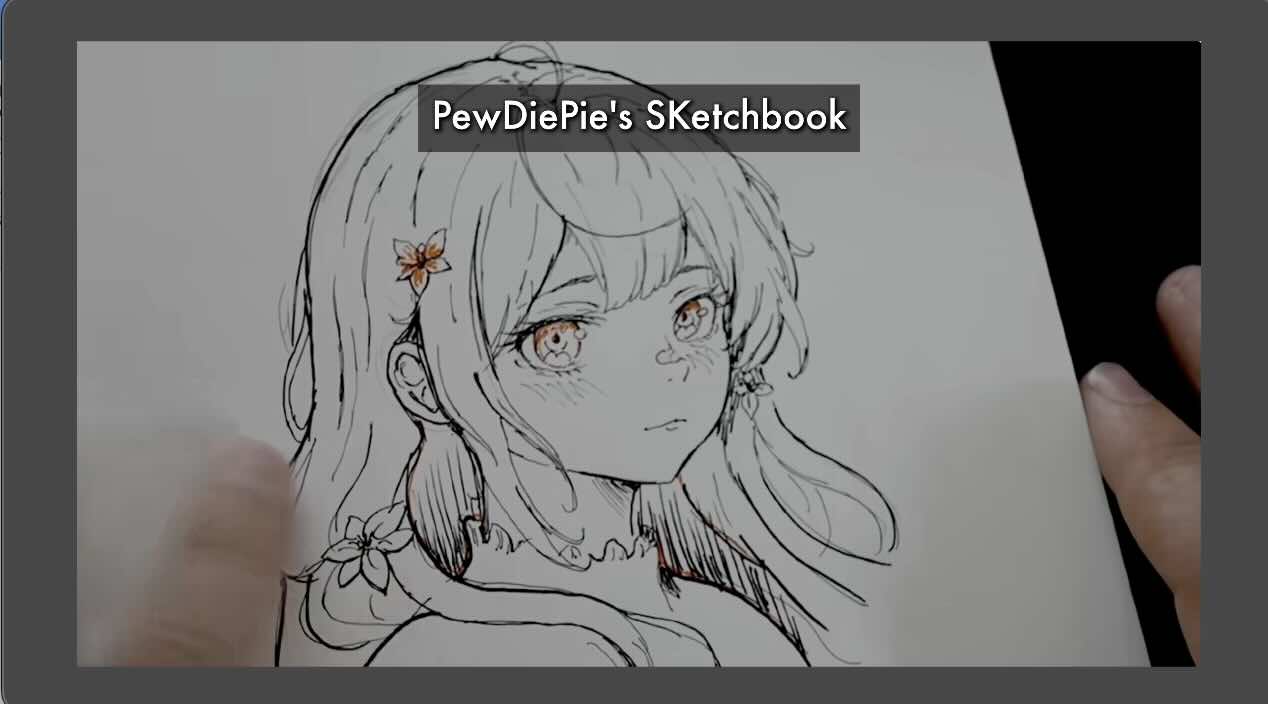
If you watched PewDiePie’s 365-day drawing challenge, you’ll recall that he noted in his sketchbooks how his progress stunted at day 90.
He said that he should have moved on to other subjects way sooner.
Having a learning plan can save you that grief, plus time, energy, and even money.
A plan will help you determine your why, what, how, when and where.

WHY
Why do you want to create art? Is it a hobby/side gig/dream job? What are your key objectives?
WHAT
What are you creating? Will you have a physical product like books, prints, a YouTube channel?
What will it look like? Format/medium/genre?
What’s the purpose? What will your projects be for? And for whom? Your portfolio, galleries, customers, students?
Perhaps your purpose is to create art for the rest of your life (into old age) and want to find ways to do this consistently.
Why + What = Your Vision

HOW
With the “How” get more specific. Assess your current situation, such as gaps in skills and knowledge.
A gap in skills means that you need more practice in a particular area – to achieve your vision.
A gap in knowledge means you’re missing information to make progress.
PewDiePie learned how to draw anime-girl faces. He consistently practiced anime-girl faces to develop that skill.
When he tried to draw the body or other subjects, he realized there was a knowledge gap.
He therefore looked for resources to teach him what was missing. Then practiced those new concepts to grow his skills, and so forth.
What skills do you need to practice? What knowledge is missing for you to progress? This will answer the “how”.

WHEN
For the “When”, this is your timeline.
How much time will you invest in your development?
How often will you practice?
Even better if you have a deadline.
PewDiePie started with a 30-day challenge, as his first deadline.

WHERE
For the “Where”, this is more about where your learning resources come from.
Rather than random lessons or general art books, you get specific with the topics and the sources of instruction.
Having a plan means you’ll be more successful in matching the resources to your learning needs.
For example, you may decide that investing in a course program is worthwhile now that you have a clearer direction for what you need.
The ‘when’ and ‘where’ inform the ‘how’.
PewDiePie said, after reflecting on his journey that he learned best from:
- watching the process of other artists,
- getting feedback from professionals, and
- specific books, such as Taco’s Character Drawing Anatomy.
📖 For more guidance on how to set up a learning plan read the “The 5 Steps to Becoming a Better Self-Taught Artist”.
2. Track your progress
A plan helps you track your progress more concretely.
One of my learning objectives is to share how I teach myself art.
In my 2023 learning plan, I was practicing how to draw clouds.
This year, I shared a cloud tutorial with you. The learning plan got me there.
Other Helpful Tips to Track Your Progress
Time your drawing sessions.
For example, in 2022 this dip pen and ink sketchbook study took about 5 hours. Compared to a similar study, using the same tools, in 2024 took under 2 hours.
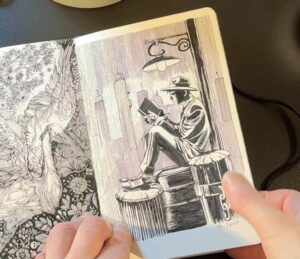
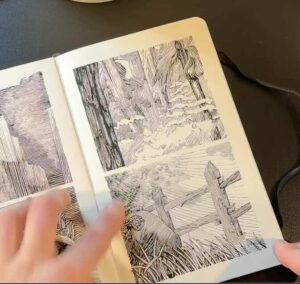
This tells me that the workflow I’ve been using is helping with my pen and ink decisions. I’ll talk more about workflows further down.
Remember to date your sketchbooks and final drawings so you have that year-to-year timestamp for comparison.
Those time records are super helpful when you:
- Retake previous lessons
- Rework old pieces
- Revisit subjects
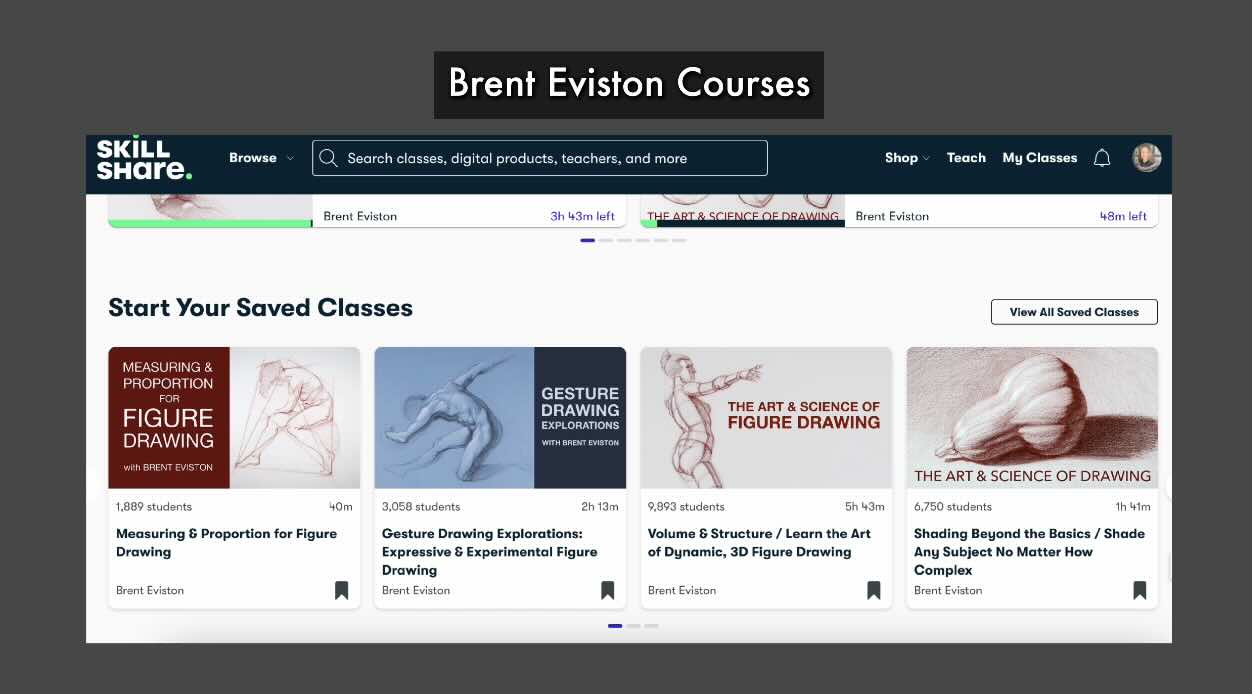
In 2021, I took Brent Eviston’s Figure Drawing courses.
I had zero prior experience drawing people, my sketches turned out so-so.
I was proud of those, but I didn’t quite grasp the concepts at the time, I got lost trying to practice once the class was over.
I ended up not applying what I learned in my projects. Concluding I sucked at drawing people.
My point here is – don’t give up.
Now I understand that figure drawing is an art fundamental that was too advanced for where I was in my journey.
I’m currently re-taking Brent’s figure drawing courses.
🎓 You can too! Click here for a free 1-month trial of Skillshare.
The concepts make way more sense now because I’ve since worked on the primary fundamentals (shape, form, shading). I’ll talk more about the fundamentals in a bit.
If you’re struggling, just park that subject and return to it later.
It was the same with my bird drawings; I only progressed because I broadened my scope.
You might be thinking that’s common sense, but at the time, I lacked the confidence to trust that it was a lack of experience and nothing to do with talent.
January is a good time to review your past year of art making.
I fine-tune my learning plan quarterly, to stay on track, monitor progress, and make changes.
Assess what went well and what didn’t.
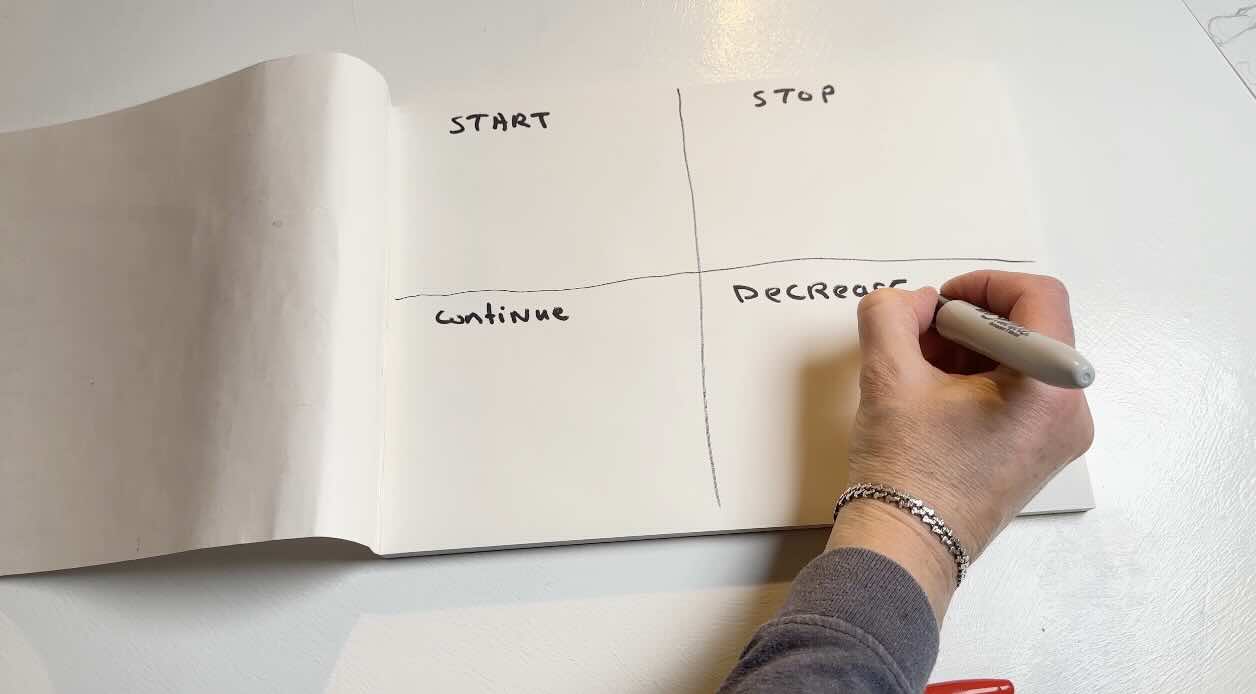
From there, divide a page into four sections (Start, Stop, Continue, Decrease).
Decide what you want to do in the next 365 days:
START
What will you start doing to gain knowledge and skills to achieve your vision?
This could be something you’ve never tried before or something you used to do and want to restart.
For example, I used to draw every single day, even for just 5 minutes. That was a positive, so I want to reinstate this as a regular habit.
STOP
What gets in the way of you achieving your vision, that you can stop doing?
Could be as simple as not limiting the scope of what you draw, and it can also be stopping a negative thought pattern that’s holding you back as an artist.
CONTINUE
What are you already doing that is working well for your creativity? What is important to keep doing or that you want more of?
DECREASE
What can you decrease that will allow you to do more of what you want?
This could be as simple as reducing distractions when you’re trying to be creative.
Write down all of those ideas in your plan so that you can monitor your actions.
And that takes us to the next habit: having strategies to stay consistent!
3. Strategies to Stay Consistent
With a vision, specific goals, timelines, and a means to track your progress, a learning plan can be all you need to stay consistent.

What about staying motivated?
I agree with PewDiePie who says that “Motivation comes and goes. Motivation is unreliable. A routine and a mindset are what help you stick to it!”
We all know that routine and mindset can quickly get off track unless you have a strategy.
As part of your plan, write down all the things that help you maintain a routine.
Look for ways that you can keep doing those things to build good habits.
What distracts you from your goals?
List negative triggers that affect your mindset. Write down strategies to help you avoid those.
The general idea is to increase the positives and decrease the negatives.
Typically, we don’t think about this until there’s a problem.
Having a strategy lets you make micro-adjustments along the way.
This could be as simple as blocking time in your schedule and turning off the APP notifications in your device’s settings.
Or as extreme as a life makeover to pursue your art goals full-time.
I started integrating minimalist philosophies into my lifestyle such as regular decluttering.
These small actions have had a huge impact on my art practice.
🎥 To learn more about simplifying your life to do more of what you love, check out Seve’s YouTube channel.

4. Prioritize the Fundamentals
I talk a lot about the art fundamentals.
For pen and ink, I found that this pyramid sequence (above) works quite well.
Click to download this Fundamentals Self-Assessment for FREE.
🎓 For a comprehensive guideline on the Fundamentals for Pen and Ink check out my Dip Pen Course on Udemy or on Skillshare.

5. Art Challenges
I’m a big fan of joining art challenges to stay consistent.
There are tones to choose from year-round. It’s easy to find one to match your goals.
You can create your own daily challenge as PewDiePie did. Or weave your objectives into the given prompts for that challenge.
I didn’t have time to do Inktober this year. As a solution, I did “all 33 prompts in a single day” incorporating my objective of getting better at quick sketching.
This turned the challenge into an exercise and a lot of fun too.
📔 You’ll find a guideline for completing Art Challenges in my Shop.

6. Choosing Exercises
Having a learning plan makes it easier to choose exercises that promote the results you want.
Let’s say that your Vision is to do portraits.
Then look for practice exercises that help you build the fundamentals which most apply to portraits.
Stan from Proko advises to “Start simple – simple shapes, get the form, light and shadow, and then add the design detail.”
Maybe for one month, practice doing head silhouettes for shape. Next month do face construction for the form. Then practice your shading with spheres. And finally progress to the details.
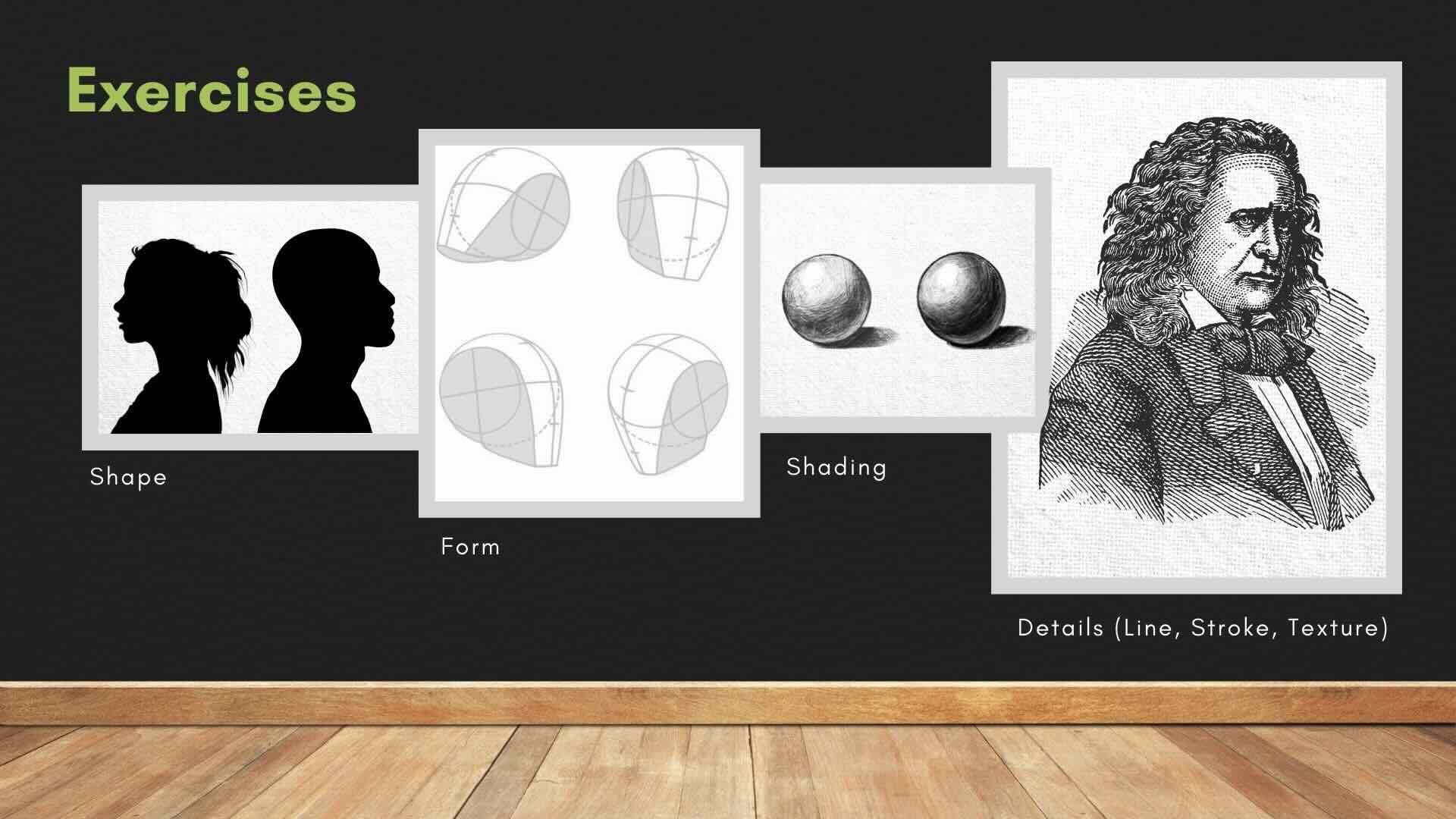
🎓 Check out Proko’s Drawing Basics Class.
7. Warmups and Sketching
If I’m working on a final piece, I do a physical warmup, to get the blood flowing to my drawing limbs. Remember that your eyes and posture also play a role.
If it’s a practice session or I’m taking a class, I use sketching as part of my warmup.
I’ll try absurd ideas and random doodles to warm up the imagination.
🎥 Watch my “direct-to-ink” video for ideas on drawing exercises
🎥 Check out Julia’s physical mobility YouTube channel

8. Establish a Workflow
You’ll gain confidence with your inking projects by using a workflow.
A workflow ensures that you complete your projects, from idea to final artwork.
Sketchbooks are great for studies but not for progress. You’ll want to draw with intention if progress is the goal. That means aiming to finish your pieces.
My workflow is a 5-stage process, which you’ll be very familiar with from my other blog articles:
- Research
- Thumbnails
- Subject Study
- Pencil Underdrawing
- Ink Application
🎥 Watch this Mermaid process on YouTube to see the workflow in action.

9. Study the Masters
Studying the Masters helps with understanding their process and decisions in an effort to improve results in our own works.
Arthur L. Guptill says that “one of the most valuable methods of learning about pen and ink drawing is through studying the best available works by other artists”.
In my experience so far, studying the masters develops:
- Observation skills
- Decision-making
- Problem-solving
- Visual communication
Of course, technical skills will benefit, as well as growing your knowledge base.
📗 Get your copy of the “Rendering in Pen and Ink” book by Arthur L. Guptill.
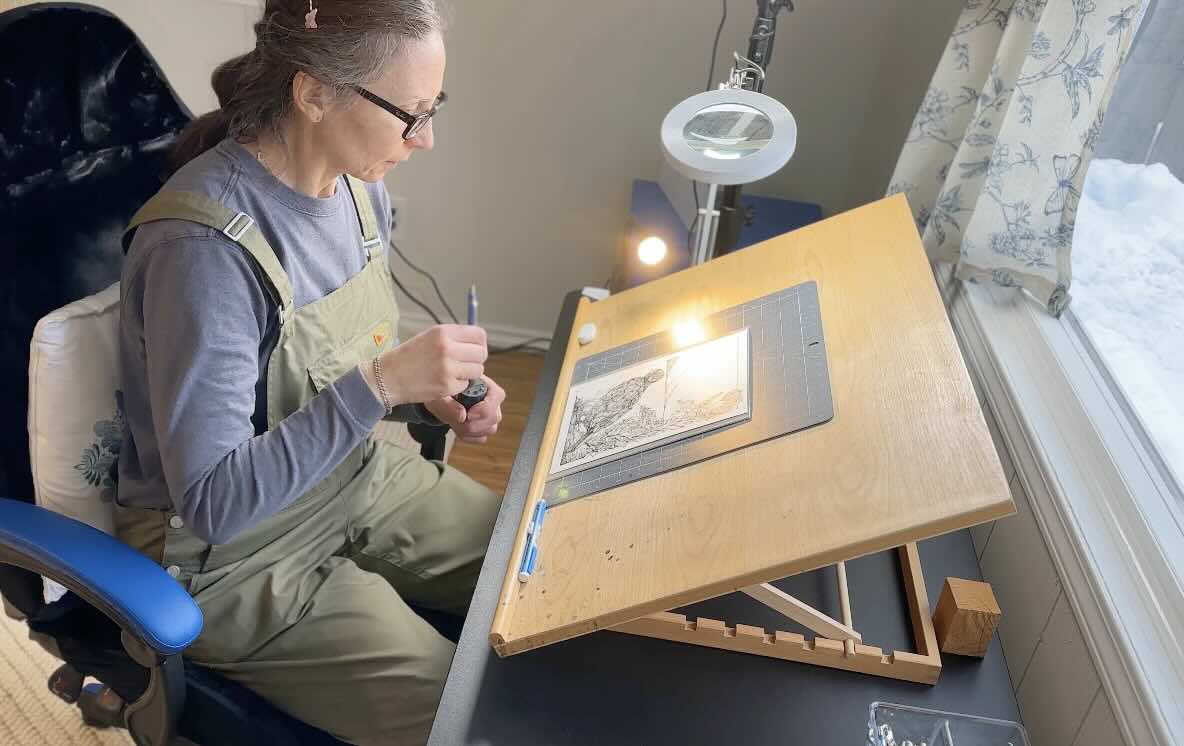
10. Tools and Setup
What’s important about tools is that you learn to control them.
There are effective ways to hold each of the tools for the results you want.
Pencils, brushes, brush pens, fine liners, dip pens – each behave differently. The same goes for how they interact with the drawing surface, paper, ink, etc.
It’s helpful to watch the pros in action with their tools and setup, particularly the angle of their drawing board.
🎥 Watch this Musashi video on YouTube where I study how Takehiko Inoue holds his tools.
For me, the tools and setup are not a top priority, yet important enough to maintain as a habit.
“A tip is advice that you can try out, a habit is part of your life, through consistent practice.”
And those were the 10 habits that most helped me progress as a pen and ink artist.
I wish you all the best with your Learning Plan in the New Year!

